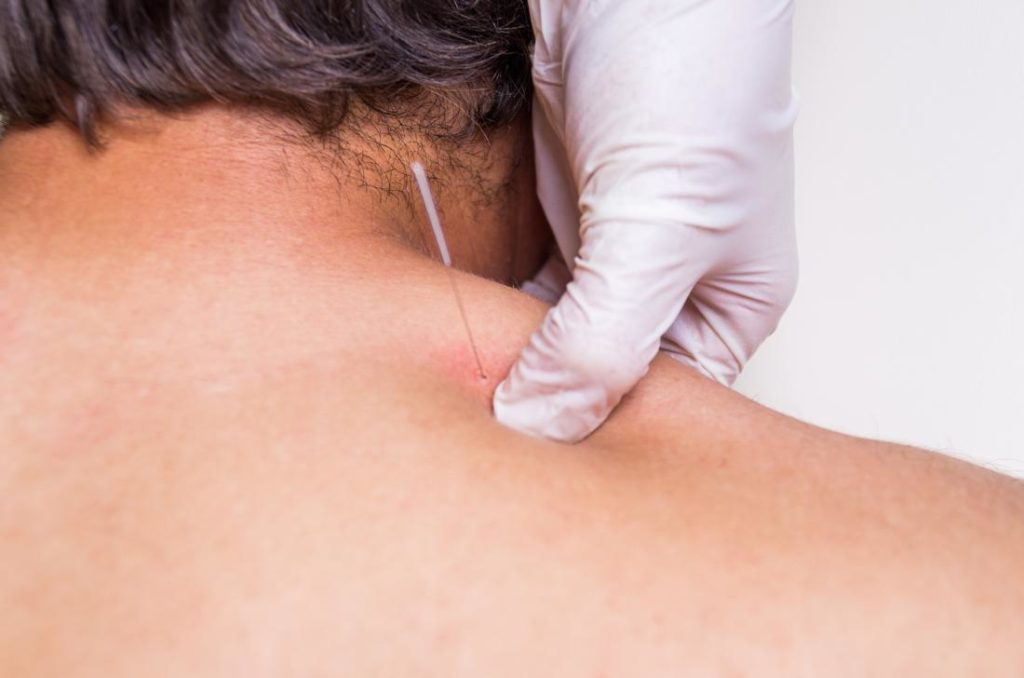What is dry needling?
Dry needling is a targeted treatment for musculoskeletal pain that eliminates myofascial trigger points and restores range of motion. Dry Needling is a technique designed to treat trigger points and their referred pain patterns. Other terms commonly used to describe dry needling, include Orthopedic Acupuncture,Trigger point dry needling, and Intramuscular manual therapy.

Dr. Josh Hanson, DACM is the most experienced dry needler near me in Tampa, FL area who has extensive training and clinical experience in both Dry Needling and Trigger Point Injections, and Regenerative Medicine. He has performed 35,000+ Dry Needling procedures, making him one of the most experienced practitioners in Florida.
What is dry needling good for?
If it hurts then dry needling can usually help. It’s great for back pain, sciatica, neck pain, shoulder pain, tennis elbow, carpal tunnel, hip pain, knee pain, ankle sprains, plantar fasciitis, and a whole lot more.
According to Hendler & Kozikowski 1993, myofascial trigger points are one of the most overlooked and ignored causes of both acute and chronic pain. At the same time, trigger points constitute one of the most common musculoskeletal pain conditions. There is a large body of evidence that muscle pain is a common and primary cause of dysfunction and not necessarily secondary to other diagnosis.
What is a trigger point?
The most common definition of a trigger point is a hyper irritable spot in a taut band of skeletal muscle that is painful on compression, stretch, overload or contraction of the tissue, which usually responds with a referred pain that is perceived distant from the spot (Simons et al., 1999).
In my dry needling clinic in Tampa, I use a comprehensive physical exam to distinguish between active and later trigger points. The physical exam has become a lost art – most orthopedic doctors don’t perform a comprehensive exam any more and instead over rely on imaging. The sad thing is your pain does not always correlate to what your MRI shows and this is well proven in the current research.
A recent study in the journal Spine by Kasch et al. (2021), stated that as we get older it’s normal to have “degenerative changes” in MRI images even if you don’t have back pain. 75% of the participants had at least one change on the MRI image, even if they didn’t have back pain.
What we can take away from this study is that back pain comes from other tissues besides just disks and arthritis. We know that muscle fibers are rich in nocieceptive receptors – meaning that muscles can sense irritation. Therefore trigger points have to be addressed when you are experiencing back pain.
How does dry needling work?
This is a super complex question, but the simple answer is that dry needling helps to clear up trigger points and their referred pain. It also helps to bring blood flow to injured areas and trigger your body to release natural pain killing chemicals.
How many treatments will I need?
That is going to depend on what you’re trying to address, your overall health status, your bodies ability to heal and what your goals are. Most people need a series of treatments but generally notice changes very quickly! Unfortunately I don’t have a magic 8 ball to predict how many treatments you will need without first performing a detailed physical exam.
Is dry needling different than acupuncture?
There is a difference between dry needling and Traditional Chinese Medicine, which is the most common system of acupuncture practice in the United States. Most acupuncturists practice traditional Chinese medicine. What makes Dr. Josh Hanson, DACM different is that he specialized in Orthopedics during his doctorate training.
Dry Needling is in-fact the same as Trigger Point Acupuncture or Orthopedic Acupuncture, which has been practiced for 2000 years. With both dry needling & trigger point acupuncture we are performing specific orthopedic assessments, and needling into muscles, tendons, ligaments and targeting trigger points. In fact, there are ancient text books that describe common orthopedic examination techniques and needling techniques that have been adopted by practitioners who think they recently discovered “dry needling”.
- What sets Dr. Josh Hanson, DACM apart from your average dry needling practitioner is that he is trained in Regenerative Injection Therapy (Prolotherapy, Prolozone, Perineural Injections, Trigger Point injections) along with Dry Needling and he takes a purely musculo-skeletal approach to treatment at his dry needling clinic in Tampa, FL.
- On top of that Dr. Hanson has performed over 35,000+ procedures – making it difficult for any other dry needling practitioner to come close to his experience level in the state of Florida.
Choose who you get Dry Needling From Wisely
- According to Gattie et al. (2020) in a survey of of physical therapists current practices in dry needling, most physical therapists only perform between 0-3 dry needling sessions a day.
- Physical therapist only need 54 hours of training to perform dry needling in Florida. Something that is often done in a coupe short weekend courses. During these courses, physical therapists learn to needle a small amount of muscles and basic protocols.
- In contrast, as an acupuncturist I have a doctorate degree and 3000+ hours of post graduate education that is purely dedicated to the art of needling. During this training we take an extensive deep dive into functional anatomy and the wide variety of muscles, tendons, ligaments and nerves that could contribute to your pain experience. This allows me to take a very comprehensive approach and use the deep clinical reasoning necessary to not just follow a cookie cutter treatment protocol, but to provide you with a thorough and comprehensive personalized treatment.
- Experience counts when you’re choosing someone to perform needling anywhere on your body.
- You can’t develop the skill and expertise it takes to become good at this with such little experience.
- I personally wouldn’t trust someone who took a short weekend course and hardly ever performs the actual procedure if I was dealing with any kind of pain.
Be Careful If Your Get Dry Needling By A Physical Therapist Who Says They Can Bill Your Insurance
I often hear people say their physical therapist can bill their insurance company for dry needling, which can get tricky and even be seen as fraud if they use the wrong billing code (which often happens). Let me explain.
In 2014, the The American Physical Therapy Association (APTA) released an official statement which can be found here or https://www.ndbpt.org/pdf/dryneedling.pdf.
You see, these big physical therapy practices try to be sneaky and say they are using a needle to perform “manual therapy” and bill using that code (CPT code 97140). But the APTA clearly states this is not how things should be done. This means you could be on the hook for these services if things are coded improperly. The problem lies in the fact that medicare has no reimbursable dry needling code, only codes for acupuncture. The legislation is clear that physical therapists CANNOT perform acupuncture and therefor cannot bill for it. And dry needling is not manual therapy, so it is a very very gray area to try and sneak around using improper billing codes.
The APTA recommended that therapists report dry needling using an “appropriate unlisted physical medicine/rehabilitation service or procedure code 97799.” Which is likely not something they will reimburse for.
The good news is that working with an acupuncturist like Dr. Josh Hanson, DACM, we can charge a fair price for dry needling / trigger point acupuncture and if you have insurance coverage for acupuncture then we can provide a special bill (superbill) that you can submit to your insurance company and they can reimburse you directly.
In contrast, Dr. Hanson has performed a huge amount of dry needling over the last 10 years.
Dr. Josh Hanson, DACM treats an average of 15-25 patients per day with dry needling (since 2011) and has performed 35,000+ dry needling treatments. It would be very difficult for any physical therapist that uses dry needling 0-3 times a day to come close to having this much experience in the state of Florida.
With dry needling I am always focused on releasing trigger points.
In the end, dry needling is a great alternative to anti-inflammatory medications, cortisone injections and can often times help you to avoid surgery. If you’re already had surgery it can speed up the healing time and help to restore function to the areas that were treated.
Related articles on how Dr. Josh Hanson in Tampa, FL helps people using Dry Needling
Dry Needling for Pinky Finger Pain(Opens in a new browser tab)
Could your knee pain be coming from your back?(Opens in a new browser tab)
Dry Needling in Tampa, FL(Opens in a new browser tab)
Does Dry Needling work for Plantar Fasciitis?(Opens in a new browser tab)
The Most Important Back Muscle You’ve Never Heard Of(Opens in a new browser tab)


